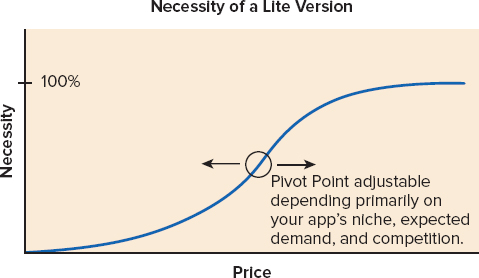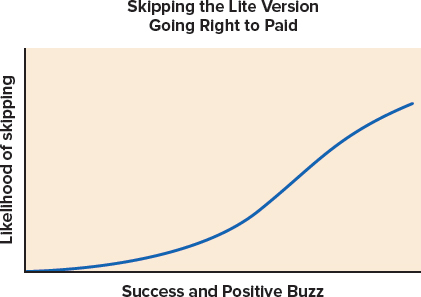BUSINESS REASONS BEHIND REVENUE MODELS
Obviously, you want to make mountains of money. The best approach to this end depends on both your long- and short-term goals for the app, as well as strategy for maintaining it (app awareness, updates, fixes, and so on), which will be the topic of discussion in Chapter 11.
Let's spend some time going over the business reasons and considerations behind choosing which pricing/revenue model to go with for various types of apps. If it turns out that none of these types of apps is for you, Chapter 8 examines the different paid models.
Free App Considerations
Following are some (but certainly not all) of the key business-motivated reasons to make a free game, regardless of whether you turn it into a freemium model:
- You're hoping to generate ad revenue — This is but one method to generate revenue in a free app, and results can vary greatly. Because of this, generating money through ads should not be the main driving factor in choosing a model; more lucrative methods certainly exist, as you learn later in this chapter.
- You're cross-selling other apps, some of which might be paid — For example, you might have a series of storybook apps, several of which are free, but a few others with more features and/or tie-in to a license/popular story that are paid. In other words, you might want buy-in to a series or your company's brand awareness (which is a very good thing), or these features could even be unrelated. Essentially, similar to how lite versions behave, you can use this as an advertisement for cross-selling your other apps.
- You have plans for paid DLC — As mentioned earlier, paid DLC plus free is considered freemium.
- You're supporting the retention of a brand — Think about the free apps for Google+, Twitter, Facebook, and so on, where customers use these apps and expect a similar app to be free. Your brand may not (and need not) be as popular as these, but it's the same idea.
Similarly, consider these reasons why a free app may not be the best idea:
- You have a foothold in your niche — This can be because of one or more unique features, and, therefore, you can support a paid app better. A model combining paid plus DLC and/or microtransactions is also becoming incredibly popular, but you must be confident in your value and/or marketing.
- Development cost is/was/will be high — In order to recoup expenses, consider making either a paid app, or paid and lite app, or even other ways to monetize (such as DLC or microtransactions and a freemium model, if that is a fit for your app).
Freemium App Considerations
Freemium apps are all the rage these days, and make up most of the top-grossing apps in the App Store for good reason. Customers want to try for free; they want value and they want options. From Facebook to the App Store, if there's one piece of advice that you can take from this chapter, for your average app, figure out how to make it freemium-based or paid with freemium-like features.
Following are some key reasons you should consider a freemium model for your next or existing app:
- Your app can be modular — You can break down your app into a core experience with enough value so as to be a complete experience. Then, if you're going the microtransaction route, you can think of several things that might enhance the experience that customers can buy. (You learn more about this later in this chapter.) Additionally, if you're going the DLC route, you can think of more significant options to add to your free app that are thought of as extras and not exactly needed, but that could be useful to a great many people.
- You want to generate long-term revenue — The best way to generate long-term revenue these days (other than by good fortune) is to create a hugely popular app that has incredible brand awareness (consider “Angry Birds,” which transitioned off screen to movies and plush toys). The best way to do this is via DLC, subscription, or microtransaction.
- You have an existing app that isn't yet freemium — This works best when you have at least a reasonably successful app within your niche, simply because you'll already have the user install base to take advantage of and/or spread the word about your new updates. However, it would be questionable to start making freemium content for an app that wasn't already doing well, unless you believed that this might somehow turn around sales (which, in most cases it won't). It's better to start with a new app in most cases like this, and develop according to the model. There are many examples of this in the App Store, one of which you learn more about later in this chapter.
Certainly the freemium model is incredibly popular and getting more so these days. But there are several reasons you may not want to go that route, including the following:
- Existing value regarded as low or near minimum — If your app is already stripped down to its essence — meaning that, if you took away a few features, there wouldn't be enough value to compel people to use it — then adding more expense to create freemium content may not be the best option until you first increase the core value. For example, consider a simple Twitter app, where the core experience doesn't have a lot of bells and whistles, and is simply to tweet. It's maybe the best at what it does — intuitive, responsive, aesthetically pleasing — but there's not a lot of anything else. Because of that, you have a fair active user base, but it's nothing exceptional yet, mainly because there are other apps that do what you do adequately, but also a bit more, making the overall value of some other apps higher.
You have two main paths if you want to eventually go freemium for long-term revenue. First, create the very best “feature #2” and offer it as an in-app purchase, in which case users might not react so favorably, or with high conversion rates. Another (better) option is to update for free with a few more in-demand features (responding at least in part to customer review needs, or some new unique features the competition has released) to increase the core value of your app so that now you have the very best tweet functionality, along with some of the other useful features competition may or may not have.
The idea is that you listen and respond to customer needs, providing more value for free, which increases word of mouth and virality. Once you stop seeing recurring missing feature requests in your app reviews (for example, “good but it needs/could use XXX”), you can feel confident that you have enough core value to start requesting money for new in-demand features.
- You have premium content — If your content is not easily duplicated, and you have a good foothold on your niche, a potentially better option would be pricing it in premium territory (which is examined in more detail in Chapter 8). This does not mean that you can't also add on freemium-like features, but if customers are paying $9.99 and up for your app, in most cases, unless your grip on the niche is secure for a while, most or all of your content should be built in.
One example that bucks the trend is premium navigation apps such as those mentioned earlier in this chapter. Because they are recognizable brands with a near monopoly in the niche (likely because of funds needed to develop that sort of sophistication, along with brand recognition), you can afford to offer not only a base package with region-based content at a premium price, but also offer additional DLC packs for additional cost.
- Your app is feature-based, not content-based — According to a smashapp.com blog article, converting users to an unrestricted full version is generally not very successful with the only motivation being the removal of ads, or if it is “feature-hobbled.” It's also much easier to create a freemium app if your app is content-based — that is, if you can restrict content instead of features, because new content is typically much easier to create than new features.
One way feature-based app developers get around this is to create a “free” and fully functional version, but offer an upgrade to the “full” version that may remove ads, as well as offer addition content in the form of “skins” for their apps. For example, consider “Calculator for iPad Free” (that's its actual name, which makes use of keywords in its title) shown in Figure 7-4. For many, it's a handy app that has all the functionality available, except for a banner along the bottom upselling you to its full version.

FIGURE 7-4: “Calculator for iPad Free” is full-featured, but offers removal of ads and additional skins for a full version
Lite App Considerations
There is only one key reason you would want to consider a lite version of your app:
- You have a paid app — As you have seen, lite apps are free and restricted versions of paid apps. What's not quite so obvious, however, is that, though supporting a paid app with a lite version can be very important, it becomes more important the higher priced your paid app is. For example, as shown in Figure 7-5, if you have a premium-priced app, it becomes almost a necessity.

FIGURE 7-5: The higher the price, the more necessary it becomes to release a lite version
![]() With “Archetype,” initially released in only its paid version at $2.99, the development team at first heavily debated whether to also release a lite version. It was finally decided fairly early, however, to price it in the mid-premium price range (given the value in unlimited multiplayer gameplay) without a lite version. In hindsight, it definitely helped, because development would have been delayed even further in creating another restricted version in parallel (which should be a big consideration). The team ended up hitting the sweet spot in terms of the unique features the game offered at the time. Releasing it any later may have had drastically different results, given the unpredictability of the market, and what the competition was doing. If development time is not a consideration for your app, then strongly consider supporting any paid version with a lite version. Ten months after release, the price of “Archetype” was dropped to $0.99 and a lite version named “Archetype: Cadet” was released, which follows the guidelines outlined in this book for lite apps (namely, finding that good value balance and upsell incentive).
With “Archetype,” initially released in only its paid version at $2.99, the development team at first heavily debated whether to also release a lite version. It was finally decided fairly early, however, to price it in the mid-premium price range (given the value in unlimited multiplayer gameplay) without a lite version. In hindsight, it definitely helped, because development would have been delayed even further in creating another restricted version in parallel (which should be a big consideration). The team ended up hitting the sweet spot in terms of the unique features the game offered at the time. Releasing it any later may have had drastically different results, given the unpredictability of the market, and what the competition was doing. If development time is not a consideration for your app, then strongly consider supporting any paid version with a lite version. Ten months after release, the price of “Archetype” was dropped to $0.99 and a lite version named “Archetype: Cadet” was released, which follows the guidelines outlined in this book for lite apps (namely, finding that good value balance and upsell incentive).
Following are some reasons to think twice about creating a lite app, even if you have a paid version:
- You already have a successful or known Intellectual Property (IP) — In this case, an app/game already is somewhat established, as shown in see Figure 7-6. If this fits your scenario, the necessity is lessened, though it is somewhat still there, depending on other factors. You know you'll already get your base users.

FIGURE 7-6: Success of a previous IP or positive buzz can lessen (though not eliminate) the need for a lite version
- You have recently released an app that's $0.99 — This price is within the impulse buy-and-try range (but still not free). Therefore, you'll have to judge whether it's worth your development money to create two versions. The exception is if your $0.99 app is not selling well for whatever reasons, some of which have been given in Chapter 6. If that's the case, following are your considerations:
- Make it free and find another route to revenue (such as ads or possible DLC/microtransactions).
- Possibly support it with a lite version, if the cost isn't too prohibitive, and longevity of the app has the potential to stay current and in demand.
- Quality is in question for your paid app — This happens to many developers, and may have already happened to you. Maybe that's one of the reasons you're reading this book. For one reason or another — maybe it's a developer who turned out to be more difficult to work with, or less competent than originally perceived — your paid app turned out less polished or optimal than envisioned. On the other hand, maybe you did actually plan a quick-and-dirty app and, for whatever reasons, have decided to make it paid.
When this happens in the video game industry, a demo is not released with the hope of getting as many sales as quickly as possible before word of mouth has a chance to sink in and, thus, help create a hole in the boat that might sink sales. In the same way, a lite version is ill-advised because conversion to your paid version is, of course, likely to be low. This method will likely tarnish your brand's reputation (especially in written reviews of the app), so think carefully before doing this. If this is a concern, it would be better to convert it to free with any fixes/polish updates you can do, and positively spin it in a light that will make you look better to potential customers (that is, the reviews might then imply “this developer is trying or has made some progress”).
If you are going free, freemium, or lite with your app, you should now have a clearer picture of the business considerations in order to effectively make a decision on your revenue model. (Chapter 8 discusses paid versions in the same way.) Let's next delve into what the risks and rewards will be for free types of apps.
